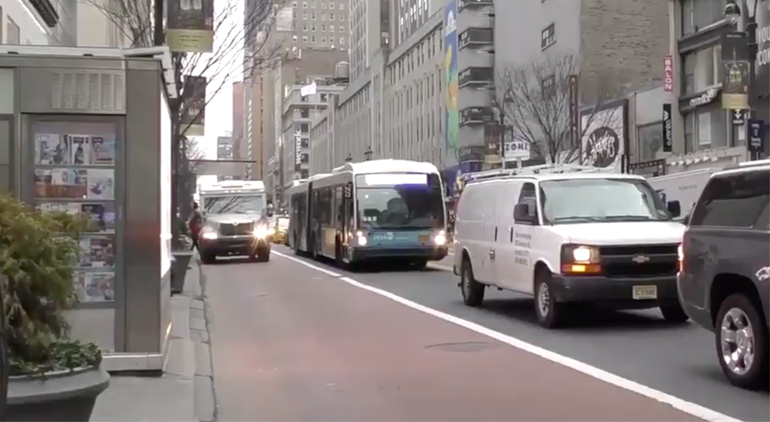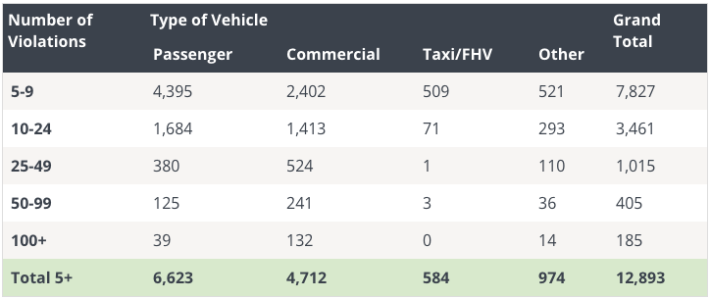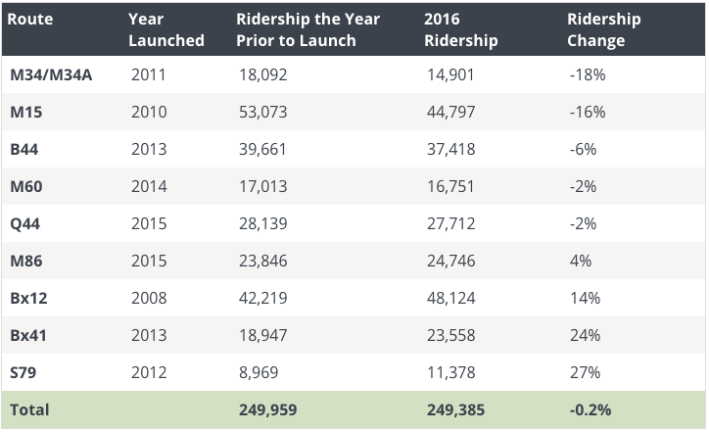Ten years ago, the MTA and NYC DOT debuted New York's first "Select Bus Service" route on the Bx12 in the Bronx. At the time, it was a breakthrough, the first route in the city with off-board fare collection and terra cotta transit lanes. Trips on the Bx12, one of the busiest routes in the city, immediately got faster, and more people started riding.
The "bus action plan" released by the MTA on Monday promises to expand those types of upgrades citywide. But to deliver for riders, City Hall and Albany will have to solve a problem that has vexed SBS routes for a decade: blocked bus lanes.
Despite success improving bus speeds, Select Bus Service has failed to increase bus ridership, according to a new report from Comptroller Scott Stringer [PDF]. And one of the main reasons is that bus lanes are not doing what they are supposed to do. They are constantly obstructed by parked vehicles, negating the benefits for bus riders.
Currently, bus lanes are enforced with cameras at 94 fixed locations along 10 routes. Those cameras aren't enough. They don't cover the whole length of bus lanes, and they're undermined by the city's own lax attitude to maintaining the integrity of transit priority on the street.
Repeat bus lane and bus stop offenders account for 28 percent of all violations. Unsurprisingly, commercial vehicles are the most likely to be cited for multiple violations. The city's stipulated fine program, which essentially allows companies to receive bulk discounts on traffic fines, reduces incentives to adhere to bus lane rules.
Riders still appreciate Select Bus Service. People surveyed by Stringer's office give the program high marks, with 64 percent of riders rating SBS with an "A" or "B." Only 27 percent gave subway service such high marks. While SBS is performing better than the bus network as a whole, the overall results are underwhelming.
According to MTA data compiled by Stringer's office, on the nine SBS routes introduced through 2015, 2016 ridership was down .2 percent compared the year before each route was implemented. That's markedly better than the 5 percent drop in total bus ridership between 2013 and 2016, but the bar for bus improvements should be higher than just stopping the bleeding.
Moving forward, Stringer recommends physical barriers for some bus lane segments and enforcement cameras mounted on every bus. The latter recommendation was one of the top-line strategies in the MTA's bus action plan, and will require authorization from the state legislature.
The comptroller's report also called on the city and MTA to hasten the implementation of transit signal priority for buses. NYC DOT is only planning to add signal priority on five bus routes per year through 2020, but the MTA's bus fleet is capable of interfacing with traffic signals on many more routes.
The MTA also needs to do a better job adhering to its own stop spacing guidelines, the report says. While the agency aims to have SBS stops half a mile apart, on five of the nine routes listed above, stops are less than 1,000 feet apart.
"Select Bus Service was a first step toward modernizing the city’s bus system. But the City and the MTA are failing those who depend on its service," Stringer said in a statement. "If we’re going to build a real and rapid bus transit system in New York City, we need to do it right. No more half measures and cutting corners."








